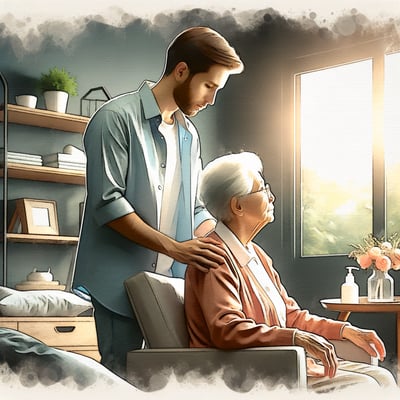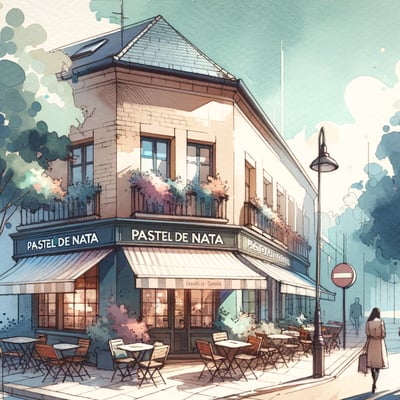1
00:00:02,405 –> 00:00:03,625
Assistente de loja: Boa tarde.
{{Shop Assistant: Good afternoon.}}
2
00:00:03,745 –> 00:00:04,865
Posso ajudar o senhor?
{{Can I help you, sir?}}
3
00:00:04,865 –> 00:00:05,945
Cliente: Boa tarde.
{{Customer: Good afternoon.}}
4
00:00:05,945 –> 00:00:07,645
Sim, pode.
{{Yes, you can.}}
5
00:00:07,645 –> 00:00:11,945
Eu preciso de um fato e de sapatos novos.
{{I need a suit and new shoes.}}
6
00:00:11,945 –> 00:00:14,060
Estou a ver estes sapatos,
{{I’m looking at these shoes,}}
7
00:00:14,060 –> 00:00:16,745
mas acho que gosto mais daqueles.
{{but I think I like those better.}}
8
00:00:16,745 –> 00:00:20,485
Assistente de loja: Aqueles são bonitos e elegantes,
{{Shop Assistant: Those are nice and elegant,}}
9
00:00:20,485 –> 00:00:21,925
mas estes também.
{{but these [are] too.}}
10
00:00:21,925 –> 00:00:24,765
Gosta mais daquela cor, é isso?
{{You like that color more, is that it?}}
11
00:00:24,765 –> 00:00:28,625
Cliente: Sim, mas gosto mais deste preço!
{{Customer: Yes, but I like this price more!}}
12
00:00:28,625 –> 00:00:30,465
Assistente de loja: Depois de escolher o seu fato,
{{Shop Assistant: After you choose your suit,}}
13
00:00:30,465 –> 00:00:32,185
pode decidir que sapatos prefere.
{{you can decide which shoes you prefer.}}
14
00:00:32,185 –> 00:00:33,365
É mais fácil.
{{It’s easier.}}
15
00:00:33,365 –> 00:00:34,705
Cliente: Talvez, sim.
{{Customer: Maybe, yes.}}
16
00:00:34,985 –> 00:00:39,485
Assistente de loja: Eu sugiro um daqueles fatos azuis, naquele canto.
{{Shop assistant: I suggest one of those blue suits in that corner.}}
17
00:00:39,485 –> 00:00:43,005
São clássicos, mas com um toque moderno.
{{They are classics, but with a modern twist.}}
18
00:00:43,005 –> 00:00:45,305
Os homens parecem mais novos neles.
{{Men look younger in them.}}
19
00:00:45,305 –> 00:00:47,565
Cliente: Está a tentar dizer alguma coisa?
{{Customer: Are you trying to say something?}}
20
00:00:47,565 –> 00:00:49,035
Assistente de loja: Eu?
{{Shop assistant: Me?}}
21
00:00:49,035 –> 00:00:50,035
Não, não!
{{No, no!}}
22
00:00:50,035 –> 00:00:51,434
É só uma sugestão!
{{It’s just a suggestion!}}
23
00:00:51,434 –> 00:00:53,865
Cliente: Estou a brincar, jovem.
{{Customer: I am joking, young [lady].}}
24
00:00:53,865 –> 00:00:56,185
Você é boa nisto.
{{You are good at this.}}
25
00:00:56,185 –> 00:01:00,985
Eu gosto daqueles fatos, obrigado pela sugestão.
{{I like those suits, thanks for the suggestion.}}
26
00:01:00,985 –> 00:01:04,844
Assistente de loja: E o que acha dessa camisa ao seu lado?
{{Shop assistant: And what do you think of that shirt next to you?}}
27
00:01:04,845 –> 00:01:06,585
Cliente: Esta?
{{Customer: This one?}}
28
00:01:06,585 –> 00:01:08,165
Não gosto das riscas.
{{I do not like stripes.}}
29
00:01:08,165 –> 00:01:11,985
Prefiro uma daquelas camisas lisas.
{{I prefer one of those plain shirts.}}
30
00:01:11,985 –> 00:01:16,525
Vou levar uma delas e levo também o fato azul.
{{I will take one of them and I’ll take the blue suit too.}}
31
00:01:16,525 –> 00:01:18,765
Assistente de loja: Ótimas escolhas.
{{Shop assistant: Great choices.}}
32
00:01:19,005 –> 00:01:20,845
Quer experimentar a roupa primeiro?
{{Do you want to try on the clothes first?}}
33
00:01:20,845 –> 00:01:22,165
Cliente: Sim, por favor.
{{Customer: Yes, please.}}
34
00:01:22,165 –> 00:01:23,365
Assistente de loja: Então pode vir comigo,
{{Shop assistant: Then you can come with me,}}
35
00:01:23,385 –> 00:01:27,405
nós temos camisas e fatos prontos para experimentar.
{{we have shirts and suits ready to try on.}}

 Eliana
Eliana Rui
Rui











Indeed, thanks!
This one was relatively hard for me. There were a number of words that were either new to me or I had forgotten them. But I was able to answer all the questions right without understanding fully what was going on.
There is a reference to’ canto ‘ as corner. Does esquina refer to an outer corner and canto to an inner corner?
Just this sentence was a bit too fast for me speed wise otherwise v good shorty
Depois de escolher o seu fato,pode decidir que sapatos prefere.
What does the é isso mean in the sentence Gosta mais daquela cor , é isso literally (it is that) ?
Does it mean “than that” ?
Olá! “É isso” in that context means “is that it”, i.e. “is that why you prefer the other shoes”?
muito obrigado
“Você é boa nisto.”
Again, I was told by my tutor that você is not used, but one speaks in the 3rd person for formal, “O senhor é boa nisto”.
Olá again Ron!
You’re right. Again, “você” shouldn’t be used. In this case should be “A senhora é boa nisto”. Or even “A menina é boa nisto”, since he’s an older man talking to a younger woman. The fact that he’s using the word “você” can be justified by the fact that these shorties are usually meant to be comedic, and “você” – for not being the most correct formal treatment – gives the idea that this client is a man not so educated as he wants to appear to be. Just like the flamboyant man on the other shortie!
I hope I’m not getting you even more confused about this!
Please let us know if you’re still struggling with this subject.
Cheers,
Luís
Couldn’t recall seeing “……é isso?” before among the useful phrases highlighted to learn
I was delighted to understand most of what was said the first time around, but still learned some new vocabulary, which is always fun, like a camisa lisa being a plain shirt. After MUCH confusion, the prepositions are FINALLY starting to click for me! I long for the day when I don’t have to stop and think out things like em + Isso = nisso and just say them naturally in a sentence, but someday it will come.
From the dialogue – “I’m looking at these shoes”. You have “Estou a ver estes sapatos” but I am struggling with this because it feels like you are missing “at” I keep translating it as “Estou a ver nestes (em + estes) sapatos”. Pode ajudar-me?
It seems that you are looking for a direct translation, but the proposed translation is not word per word, but an idiomatic alternative. “I’m looking at these shoes” would directly translate as “Eu estou a olhar para estes sapatos”, which is also a possibility in this context, but not necessarily the most used one. When referring to shopping, we tend to use “estou a ver” (I’m seeing) more than “estou a olhar” (I’m looking at) 🙂
I was watching one of the videos where Rui said you should repeat the verb back to the questioner in your answer. So in the below section from this quiz, would it be better to answer with: “Sim, quero, por favor?” instead of, “Sim, por favor”?
From the quiz:
Quer experimentar a roupa primeiro?
Do you want to try on the clothes first?
00:01:20Cliente: Sim, por favor.
Customer: Yes, please.
That isn’t a strict rule! Specially being a yes or no question. Both answers – “Sim, quero, por favor” or simply “Sim, por favor” – are totally correct. 🙂
I haven’t yet bought, or even looked for, clothes in Portugal. Is Portugal one of the countries where there are specific clothes set aside for customers to try on for fit, etc? Versus picking something off the rack and trying it on then those, if not bought, go back on the rack for others to try on? I ask due to the last sentence in the shortie with “nós temos camisas e fatos prontos para experimentar.” Not really that important, but thought I’d ask.
Oh, it depends on the store and on the type of item you’re looking for. Usually, you’ll be picking items off the rack, but for some things, you might have sample items to try on and you’ll then buy the corresponding neatly packed item. This is rather common with male formal shirts, for example.